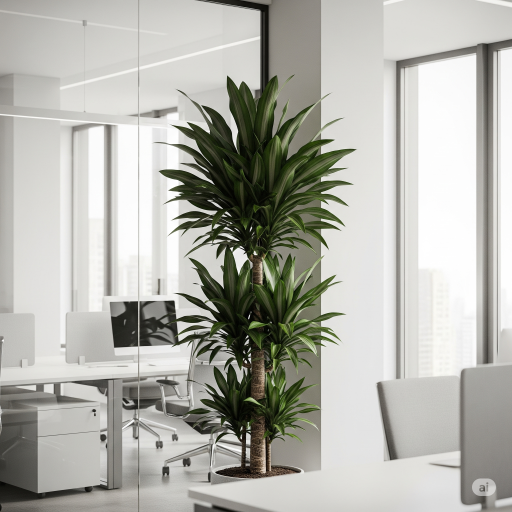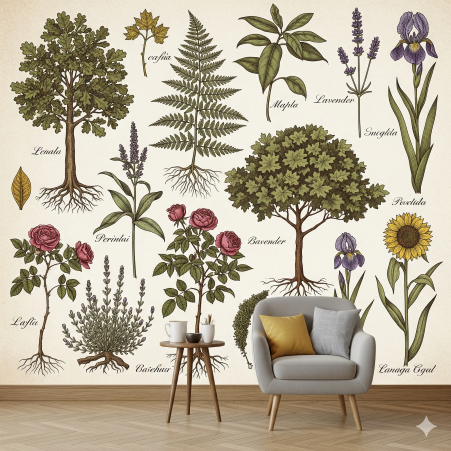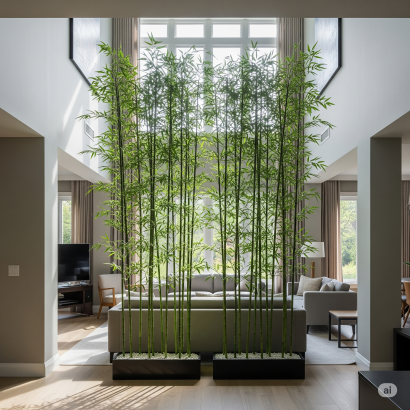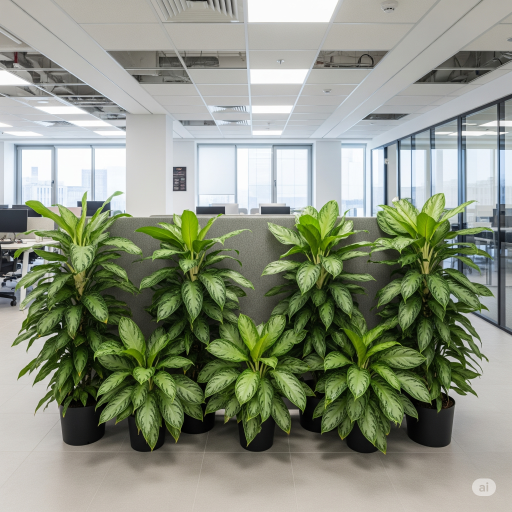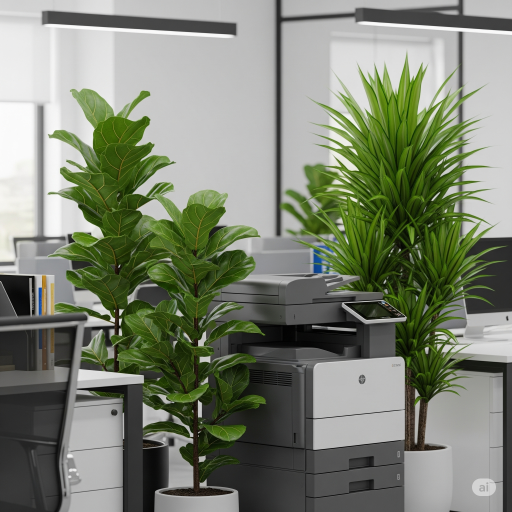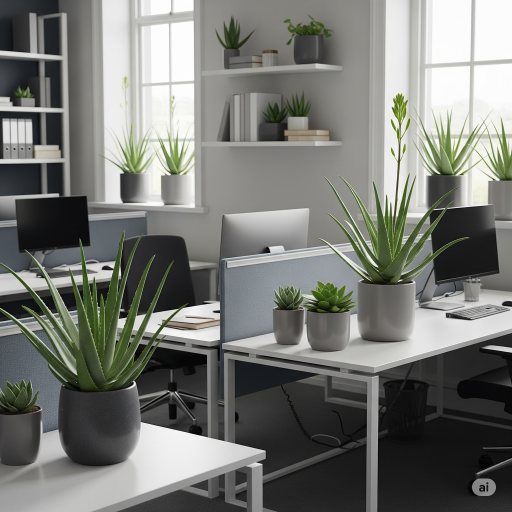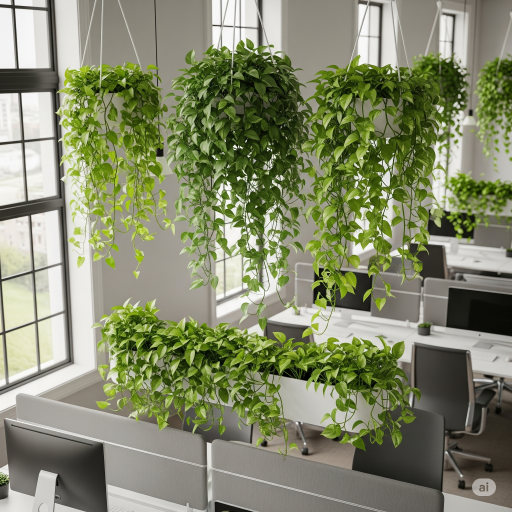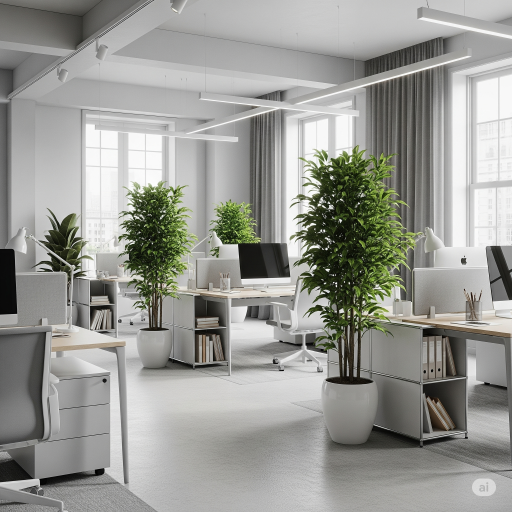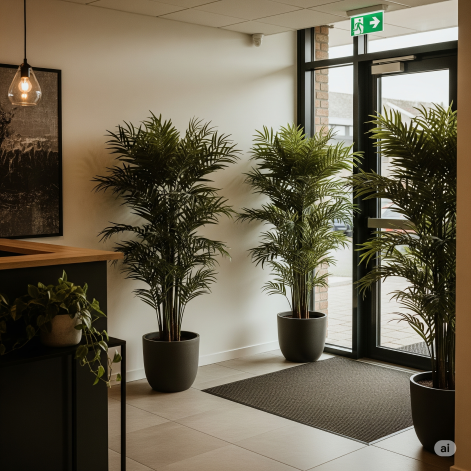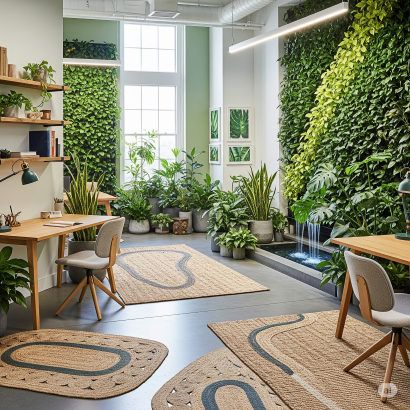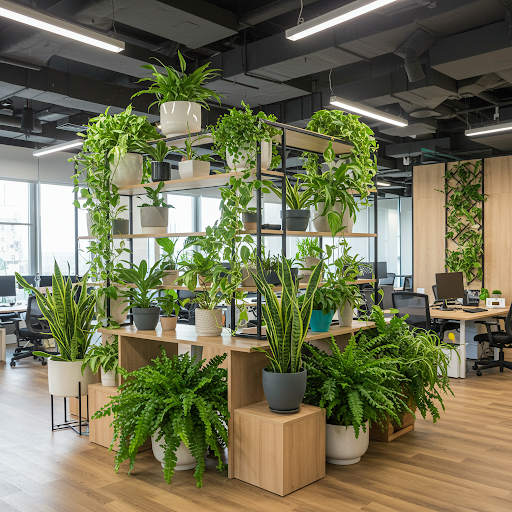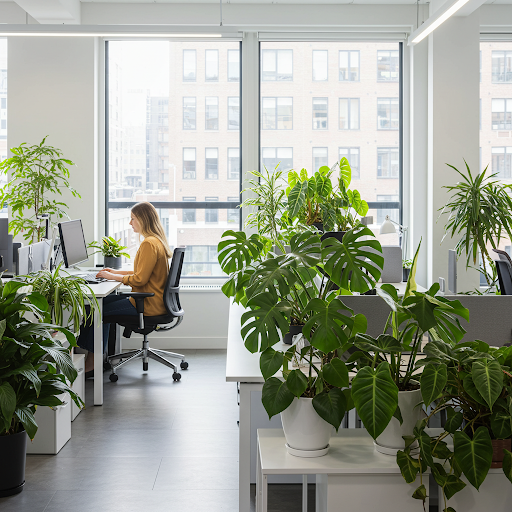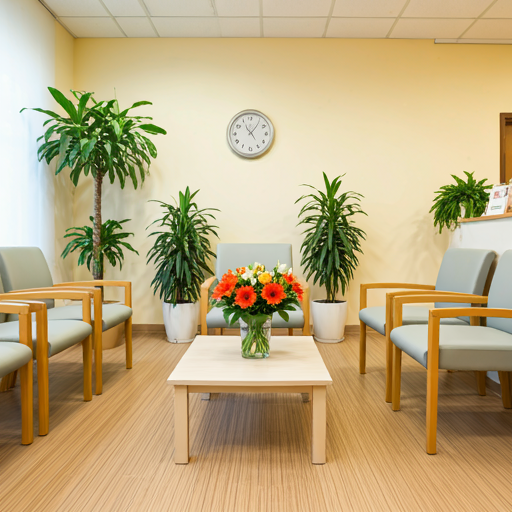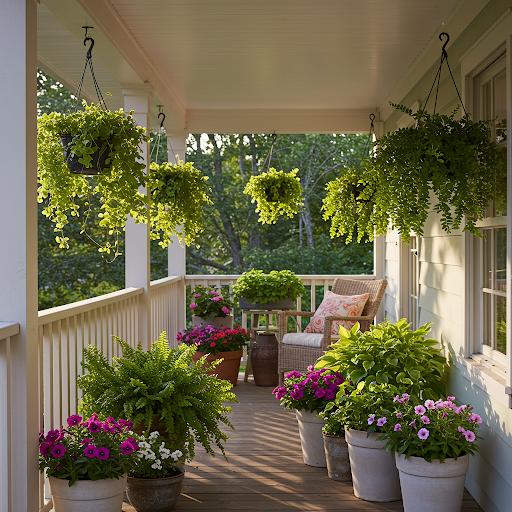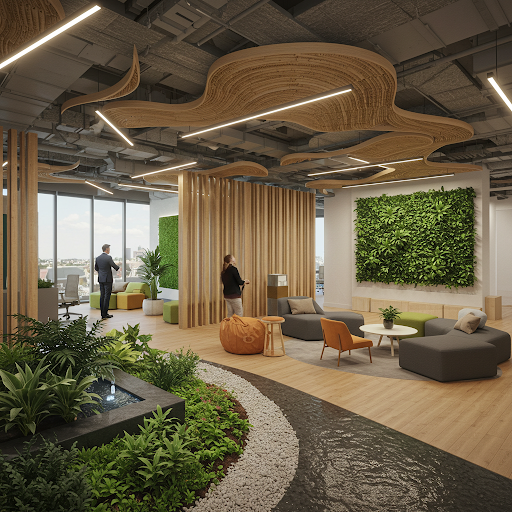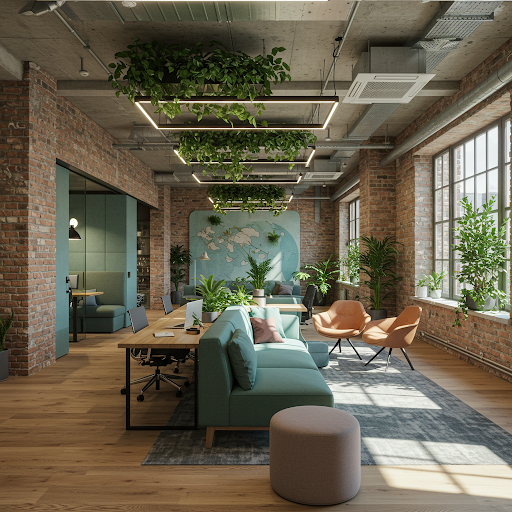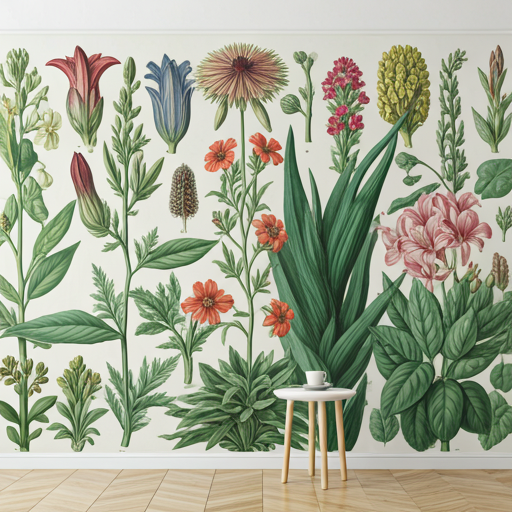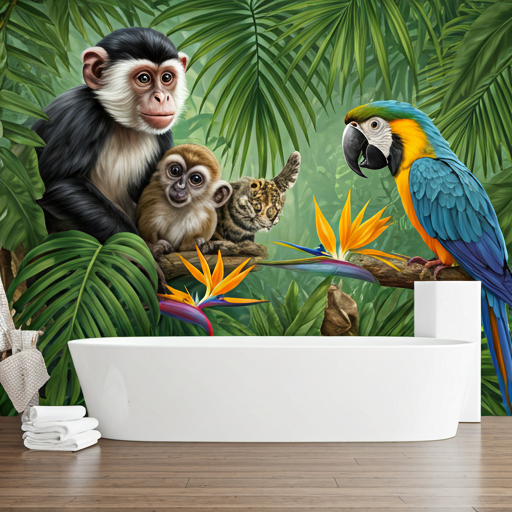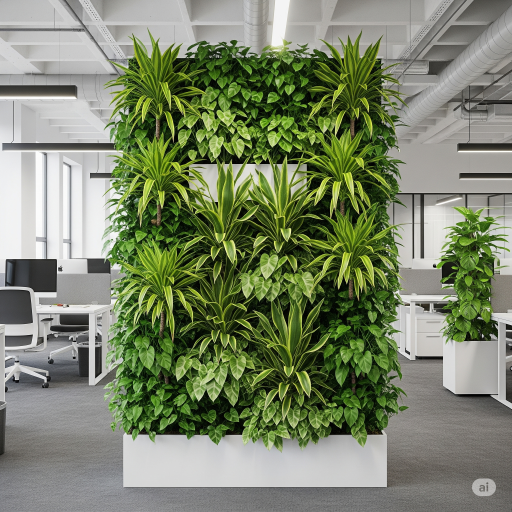Description
Interior Plantscaping, or Office Plants—the concept of connecting people to nature—is a major element in modern office development in Nairobi.
Office plants are not categorized by their species alone, but by their function, maintenance needs, and tolerance for typical office conditions.
Here is an overview of the most popular and suitable office plants, focusing on their relevance to the Kenyan workplace environment. That is fluctuating electricity/AC, dry seasons, and low natural light.
Modern office plants are strategically chosen based on the problem they solve or the space they fill.
1. The Low-Light, Low-Maintenance Office Plants
These are the most popular choices for desks, interior offices, and hallways where light is limited and care is inconsistent. They are highly drought-tolerant, making them ideal for the busy Nairobi office schedule and inconsistent watering.
The popularity of “Low-Light, Low-Maintenance Indestructibles” in commercial landscaping for Nairobi offices is driven by two main factors. That is the environmental necessity and operational practicality.
1. Adaptation to Office Environment (Low-Light)
Modern office buildings often feature limited natural light in interior desks, hallways, and cubicles. These chosen low-light plants possess specialized physiological traits to thrive in minimal light:
Increased Chlorophyll
They contain a higher concentration of chlorophyll, which allows them to capture and utilize the few available light photons more efficiently for photosynthesis.
Shade Tolerance
Many of these species, like the ZZ Plant or Snake Plant, evolved on the tropical forest floor, where they naturally grow in the shade beneath a dense canopy, making them perfectly adapted to dim indoor conditions.
2. Operational Practicality (Low-Maintenance & Drought-Tolerant)
This characteristic directly addresses the challenge of an inconsistent office maintenance schedule, especially in a busy city:
Water Storage
“Indestructibles” are typically succulents or have features like rhizomes (thick underground stems) or fleshy leaves that store water. For example, the ZZ Plant (Zamioculcas zamiifolia) stores water in its rhizomes, and the Snake Plant (Dracaena trifasciata) stores it in its leaves.
Forgiveness for Neglect
Their drought-tolerance means they are highly forgiving of irregular watering schedules (e.g., watering once a month instead of weekly), which is crucial when maintenance staff are busy or absent. Overwatering, not under-watering, is often the single biggest killer of these plants.
Air Purification
Many of these hardy plants are also renowned for their ability to purify indoor air by filtering common toxins like formaldehyde and benzene, adding a health benefit to the aesthetic function.
Key Examples of Low-Maintenance Office Plants in Nairobi:
1. Snake Plant (Sansevieria/Dracaena trifasciata)
Architecturally striking and virtually unkillable.
2. ZZ Plant (Zamioculcas zamiifolia)
Tolerates extremely low light and requires infrequent watering.
3. Cast Iron Plant (Aspidistra elatior)
The Cast Iron Plant lives up to its name—it is incredibly hardy. It tolerates deep shade, temperature fluctuations, and dusty conditions far better than most houseplants.
Key Care Tip
Water sparingly, especially during the cooler months. It’s almost impossible to underwater this plant, but easy to overwater.
5. Spider Plant (Chlorophytum comosum)
The Spider Plant adapts well to a wide range of conditions, including fluorescent office lighting. It’s famous for producing “spiderettes” (small plantlets) that are easy to propagate.
Key Care Tip
It is one of the best air purifiers and will tolerate some neglect, though it prefers bright, indirect light. It’s safe for pets (if you have an office dog!).
5. Peace Lily (Spathiphyllum spp.)
A beautiful flowering plant, Peace Lilly, that is very expressive. Like the Pothos, it dramatically wilts when it needs water, giving a clear, non-verbal signal to the office caretaker.
Key Care Tip
Prefers consistent moisture but can recover easily from drying out. It thrives in medium, indirect light but will still flower even in lower light conditions.
6. Pothos (Epipremnum aureum)
A versatile trailing vine, Pothos thrives in low light and signals clearly when thirsty by drooping.
The result is a reliable, cost-effective way to introduce biophilic design elements without requiring a significant, dedicated gardening team.
2. Tall Statement Office Plants: Focal Points and Space Division
The use of Tall, Statement Plants in commercial settings like office lobbies and reception areas is a deliberate architectural and psychological design strategy. These plants serve as living sculptures to enhance the space’s grandeur and professionalism.
The plants are selected for their height, distinctive silhouette, and foliage, allowing them to make a bold visual impact in large spaces.
1. Visual Focal Point Office Plants
In vast lobbies and reception areas, a single, impressive plant anchors the room and draws the eye.
Architectural Contrast
Species like the Fiddle-Leaf Fig (Ficus lyrata) or Giant Bird of Paradise (Strelitzia nicolai) are popular for their large, dark, glossy leaves and clean, upright growth, which contrasts beautifully with the often minimalist, hard surfaces (stone, glass, steel) of modern Nairobi architecture.
Creating Scale
By reaching heights of 6 to 9 feet, they help to humanize large, high-ceilinged spaces, preventing them from feeling cold or overwhelming. They establish a sense of scale and luxury, conveying a message of stability and affluence to clients and visitors.
2. Subtle Office Space Division
In open-plan offices and expansive lobbies, tall plants are used as natural, non-permanent barriers.
Zoning
A row of tall plants or palms (Areca Palm or Dracaena species) placed on castors can subtly divide a large room into distinct zones—such as a reception waiting area, a small informal meeting nook, and a walkway—without the need for opaque walls. They provide privacy while maintaining an open, airy feel.
Acoustics
Their dense foliage also offers a minor acoustic benefit, helping to absorb ambient noise in busy open spaces.
Common Examples
While some require bright light (like the Fiddle-Leaf Fig), others are chosen for their height and relative hardiness in lower light:
Dracaena
Various species (like the Dragon Tree, Dracaena marginata) are popular for their woody canes and slender, variegated leaves, offering height and resilience.
Rubber Plant (Ficus elastica)
Known for its thick, resilient, dark foliage and its ability to thrive even when slightly neglected, providing a robust, substantial appearance.
Their placement, often in a simple, striking designer planter, elevates them from mere decoration to integral elements of the interior design scheme.
3. The Flowering & High-Purification Office Plants
The selection of Flowering & High-Purification Office Plants is an elevated form of biophilic design, moving beyond simple greenery to actively improve air quality while providing a consistent aesthetic lift with blooms.
These plants are specifically chosen for their dual benefits: aesthetic value from indoor flowering and significant performance in phytoremediation (filtering air pollutants).
1. Air Purification of VOCs
The primary function is the superior removal of Volatile Organic Compounds (VOCs). Indoor environments, especially newly furnished offices in Nairobi, can contain VOCs like:
Formaldehyde
Emitted from carpeting, upholstery, and building materials.
Benzene
Found in plastics, synthetic fibers, and some inks/paints.
Trichloroethylene (TCE)
Used in solvents and adhesives.
Plants absorb these toxins through their leaves and transport them to the root zone, where microbes break them down. This is particularly important for “Sick Building Syndrome” mitigation, promoting employee health and focus.
2. Aesthetic & Psychological Impact (Flowering)
The ability to produce flowers indoors is highly valued in an office setting because it provides a dynamic visual accent and a psychological boost.
Color and Life
The blooms introduce a splash of color, breaking the monotony of corporate greens and neutral palettes.
Biophilic Connection
Flowering plants strengthen the connection to nature, which research suggests can reduce stress and increase productivity and creativity among office workers.
Key Examples
1. Peace Lily (Spathiphyllum)
Perhaps the most popular, Peace Lily (Spathiphyllum), thrives in low to medium light and is excellent at removing numerous VOCs (formaldehyde, benzene, trichloroethylene), while its striking white spathes provide elegant contrast.
2. Florist’s Chrysanthemum (Chrysanthemum morifolium)
A champion VOC remover, Florist’s Chrysanthemum (Chrysanthemum morifolium), is often used for removing high levels of toxins like ammonia, though it requires bright, direct light to flower consistently, making it suitable for sunnier reception areas.
3. Anthurium (Anthurium andraeanum)
Its brightly colored, Anthurium (Anthurium andraeanum), waxy spathes provide year-round color, and it is also noted for its ability to filter formaldehyde and ammonia.
The challenge with these plants, especially the high-flowering varieties, is that they often require more consistent care and brighter light than the “Indestructibles,” necessitating a more dedicated maintenance schedule.
Local Plantscaping: Office Plants in Kenya
The success of interior plantscaping in Nairobi depends heavily on managing the unique environment:
1. Drought-Tolerance and Maintenance
1. The overwhelming preference by Kenyan corporate plant suppliers is for drought-tolerant species (Snake Plant, ZZ Plant, Succulents). This minimizes plant loss during staff leave or when reliance is placed on external maintenance companies for weekly or bi-weekly visits.
2. Many commercial spaces utilize self-watering planters or sub-irrigation systems to ensure plants have a consistent water supply without the risk of overwatering (a common killer of indoor plants).
2. Air Conditioning and Humidity
1. Nairobi’s climate, coupled with constant air conditioning, can lead to very dry indoor air. Rainforest-native plants (like certain palms and ferns) can struggle.
2. The popularity of the Peace Lily is partly due to its ability to thrive in moderate humidity, and the Snake Plant’s robustness against dry air makes it a reliable staple.
3. Interior Plantscaping Services: The Leasing Model
The emergence of dedicated Interior Plantscaping Services in Nairobi, focusing on leasing and guaranteed maintenance, is a direct response to the specific challenges and priorities of modern corporate environments. This service model essentially treats plants as a managed, high-value asset, not a burden.
1. Guaranteeing Plant Health and Aesthetics
The core value proposition is the assumption of the entire risk and maintenance burden.
Professional Care
Service providers employ specialized horticultural technicians who understand the specific needs of indoor plants (light, water, humidity, pests). They conduct scheduled weekly or bi-weekly visits for precise watering, feeding, pruning, and pest control, ensuring the plants remain in peak aesthetic condition.
“Plant Guarantee”
The most critical aspect is the rotation policy. If a rented plant begins to show signs of stress (e.g., yellowing leaves, slow decline) due to low light or unavoidable office conditions, the service provider replaces it immediately with a healthy specimen from their nursery stock, maintaining a consistently high standard of indoor greenery without any effort from the office staff.
2. Operational & Financial Benefits for Offices
This service aligns perfectly with the operational needs of busy Nairobi businesses.
Cost-Effective Leasing
Instead of a high capital expenditure for purchasing large, expensive plants and equipment, companies pay a predictable monthly fee. This is often more attractive for budgeting and financial planning.
Zero Maintenance Burden
Office staff, who are not trained in horticulture, are completely freed from the tasks of watering and monitoring plant health, allowing them to focus on core business activities.
Maximizing Biophilic Return
By ensuring the plants are always vibrant and healthy, the leasing model maximizes the psychological and aesthetic benefits of biophilic design (stress reduction, productivity boost) that the office invested in.
In essence, these services allow Nairobi companies to enjoy the positive impact of robust indoor landscapes while outsourcing all complexity to experts.
Live vs. Artificial Office Plants
Live Plants are essential for Biophilic Design, offering scientifically proven benefits. They purify the air (removing VOCs), reduce stress, and boost productivity and focus. They provide an authentic, dynamic aesthetic that can enhance a brand’s image. However, they require consistent care (watering, feeding, pest control) and may struggle in low-light, high-traffic areas. This challenge is often mitigated by using leasing and maintenance services to guarantee plant health.
Artificial Plants provide a hassle-free aesthetic with zero maintenance, no allergies, and the flexibility to place them in extremely low-light or inaccessible areas. While the initial cost for high-quality, realistic options can be high, they offer long-term savings by eliminating maintenance fees. Critically, they do not offer any air purification or the full psychological boost that comes from a living organism.
The choice ultimately depends on the office’s budget, the available natural light, and the company’s commitment to employee well-being versus simple, worry-free decor.
Benefits of Plant Office Murals
The benefits of using an office plant wallpaper mural stem from the principles of Biophilic Design, which suggests humans have an innate need to connect with nature.
Compared to abstract or purely geometric designs, a plant mural offers psychological and cognitive restoration without the maintenance of live plants.
Stress Reduction
Nature imagery, even when static, has been shown to lower cortisol levels (the stress hormone). And promotes a sense of calmness and tranquility, mimicking the effect of a walk in a park.
Cognitive Boost
Landscape or botanical scenes improve focus and cognitive function. They engage the restorative parts of the brain, increasing concentration and potentially boosting productivity by up to 8% compared to sterile environments.
Space and Depth
A high-resolution mural, particularly one with a wide, receding jungle or forest view, creates a powerful sense of depth and scale in confined office spaces, counteracting the feeling of being enclosed.
Aesthetic Continuity
It provides a striking, custom focal point that is guaranteed to be vibrant and healthy year-round, unlike live plants which may struggle in low-light areas.
A plant mural is a highly effective, low-risk way to leverage the restorative power of nature in the corporate setting.

